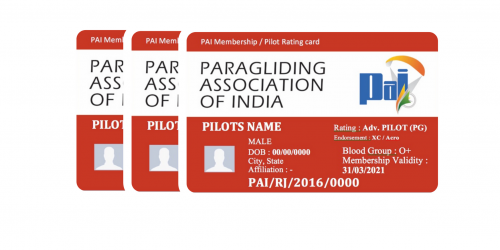In 2020 the PAI Technical Committee has spent several weeks reviewing its previously developed PPPI system and has created the National Paragliding and PPG Pilot Rating system. This system follows the FAI Parapro system closely so that our system is as robust as any international Rating System available today.
Each level has been thoroughly analysed and discussed by the PAI Technical Committee to ensure compatibility with Indian conditions. The main objectives of each level and the practical tasks to qualify have been listed out in detail.
The PAI Affiliated Schools have streamlined their courses to match with the skill levels proposed by the new system. All Students who undergo training in any of the schools will automatically qualify for the rating which will be recommended by the CFI of the concerned School and endorsed by PAI.
In order to make the Rating System available to Independent Experienced pilots who have been flying since a few years, PAI will also do an Experienced Pilots Fast Track Rating Program to evaluate the Pilot’s proficiency level and offer a Rating commensurate with their current skills. This will be discontinued at some point and all the Ratings will then go through the PAI Affiliated Schools.
This is available to all active flying Members of PAI with valid Annual Membership or Life Membership. The Rating as well as the Pilot’s affiliation are endorsed on the Membership cards.

A pilot goes through many stages of developing and improving his skills, this is an ongoing process throughout his flying career. If there is a gap in his flying of over 6 months he needs to brush up his skills before he ventures to flying in challenging conditions.
A beginner level pilot starts his flying under supervision and guidance. However he is quickly ready to venture out on his own because the pace of learning in paragliding/PPG is very fast. Paragliding/PPG can be enjoyed in smooth laminar sea breeze as well as in thermic and dynamic wind conditions, it is important to understand which conditions are suitable for you. Overconfidence is a major stumbling block in progression that can be dangerous, both for the pilot and others flying with him. Theoretical knowledge and skill along with right attitude and physical fitness level is important in the sport. Knowledge of wind and weather conditions at different locations and over varied terrain is important to evaluate and analyse the flying conditions.
Rating system is not a license. It is a task based syllabus which needs to be demonstrated by a pilot in presence of his instructor. Theory exams help gauge the understanding. The completed tasks have to be noted in a log book with date, location and weather conditions duly signed by the instructor and student. Ideally a student pilot completes certain level of his training with his instructor who is responsible for ingraining the right attitude and qualities in his student to become a safe and responsible pilot. We strongly believe that a training school should take this responsibility of rating their students up to NOVICE (P3) level. A student should not be in a hurry to become independent or behave irresponsibly by venturing to a new site without getting clearance from his instructor. He can however change his instructor or location of flying during the course of his training.
Mastering the skills and understanding the sport of Paragliding/PPG is a challenging process with overwhelming rewards. In order to progress exploring beyond local school is critical and important. Flying at different locations with varying wind and weather conditions helps in developing flying skills while understanding the limitations. Talking to local pilots and observing flying of fellow pilots is important once you visit a new site. Reading, watching videos exchanging knowledge with experienced pilots helps in understanding the sport better and thus improving your skills. Flying community is generally helpful; most instructors and pilots know each other because the community is still very small. However a rating system is a good method of evaluating ones skills and improving each other’s comfort level when we share a ridge or a thermal. In PILOT (P4) level and above, pilots skills are evaluated by two or more senior instructors appointed by PAI for the purpose.
Rating system will help in getting insurance cover as well as increase your credibility and respect in flying community. In absence of national licensing system, the rating card will add value to your credentials while dealing with local authorities.
The rating system is designed by the technical committee consisting of CFI’s of various schools in India who have been involved in the sports for over 10 years
Rating is a certificate of Pilot Skill level based on experience, acquired practical skills and theoretical knowledge.
There are 5 levels at present available to all members
STUDENT, NOVICE, PILOT, Advanced Pilot and Sports Tandem
Note : for PPG comparison chart please refer to the National PPG Pilot Rating System

No, it is just a record of Pilot skill and experience level. It is strictly NOT a LICENSE.
If you are doing or have done a Paragliding course (including Theory test) please contact your School and they will guide you.
If you would like to update your rating on equivalence, you can apply directly by filling up this form…
